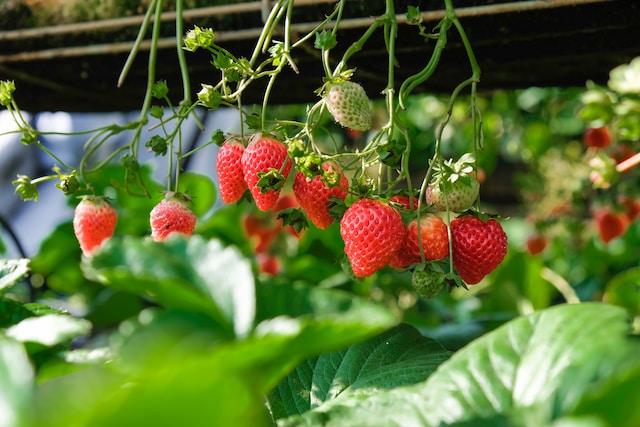Strawberries, those vibrant and delectable fruits, hold an esteemed place in the hearts and palates of people worldwide. With their sweet-tart flavor and versatility, it’s no wonder that 94% of households indulge in these succulent berries.
However, amidst their popularity lies a question: Are strawberries perennials or not? This exploration will unravel the mystery surrounding the lifecycle of strawberry plants, delving into their potential to thrive year after year or require replanting. Take this journey and uncover the truth about the perennial nature of these beloved fruits.
History Of Strawberries

The origins of strawberries can be traced back to ancient times, with evidence of their existence dating back to the Stone Age. Various cultures cherished Native to temperate regions of the Northern Hemisphere wild strawberries for their sweet flavor and medicinal properties.
The ancient Romans and Greeks held strawberries in high regard, using them for medicinal purposes and considering them symbols of love and beauty. The Romans even cultivated strawberries in their gardens and used them for culinary delights.
During the Renaissance period, strawberries gained further popularity. European explorers discovered larger varieties in the Americas and brought them back to their homelands. These new varieties were larger, juicier, and more flavorful, captivating the palates of the aristocracy.
In the 18th century, the cultivation of strawberries became more widespread with improved farming techniques. The United States played a significant role in advancing strawberry cultivation, with the first commercial strawberry farm established in the early 19th century. Cultivation methods evolved, and new varieties were developed to enhance flavor, size, and yield.
Strawberries gained even more popularity in the 20th century, becoming a staple fruit in many households. Improved transportation allowed for widespread distribution, making fresh strawberries available year-round.
Today, strawberries are not only enjoyed fresh but are also used in various culinary creations, including desserts, jams, and beverages. Their vibrant red color, succulent taste, and nutritional benefits continue to make them a favorite among people of all ages.
The rich history of strawberries showcases their enduring appeal and significance in human culture. From ancient civilizations to modern times, strawberries have been cherished for their delectable flavor, vibrant appearance, and versatility in culinary creations.
Are Strawberries Perennials?

To understand whether strawberries are perennials or not, it’s important to differentiate between perennial and annual plants. Perennial plants are those that have a lifespan of more than two years, meaning they can survive and produce for multiple growing seasons. On the other hand, annual plants complete their lifecycle within a single year and need to be replanted each season.
When it comes to strawberries, they possess characteristics of both perennial and annual plants. The strawberry plant itself is a perennial, capable of living and producing fruits for multiple years under the right conditions. However, the above-ground parts of the plant, known as the crown and leaves, usually experience a shorter lifespan, typically lasting around 2-3 years.
After the initial planting, strawberry plants typically produce the most vigorous and abundant harvest during their second and third years. Over time, productivity may decline, and it becomes necessary to rejuvenate the plants by replanting newer runners or daughter plants.
With proper care and maintenance, strawberry plants can persist as perennials in the garden, continuously producing a bountiful harvest for several years. However, the specific lifespan of strawberry plants can vary depending on factors such as the variety, growing conditions, and management practices.
In summary, while the above-ground parts of a strawberry plant may exhibit characteristics of an annual plant, the plant itself is considered a perennial. By carefully managing the plant and renewing it through propagation, gardeners can enjoy the benefits of perennial strawberry production year after year.
Strawberry Varieties And Their Benefits

In the pursuit of creating elements of a beautiful garden, incorporating strawberry plants can offer both aesthetic appeal and numerous garden benefits. When selecting strawberry varieties, gardeners have many choices, ranging from common cultivars to heirloom treasures, each with distinct characteristics and advantages.
- Common Varieties: Popular strawberry cultivars like ‘Chandler,’ ‘Seascape,’ and ‘Albion’ are renowned for their exceptional flavor profiles. These varieties often produce large, juicy berries with a perfect balance of sweetness and acidity. They are ideal for fresh consumption, adding a burst of flavor to salads, desserts, and even beverages.
- Heirloom Varieties: Embracing the charm of nostalgia, heirloom strawberry varieties like ‘Hood’ and ‘Sparkle’ bring forth a rich heritage and unique flavors. These time-honored cultivars often possess robust, aromatic flavors that harken back to yesteryears. Their uniqueness and historical significance can add a touch of nostalgia and character to any garden.
- Disease-Resistant Varieties: Some strawberry varieties are bred for their natural resistance to common diseases, ensuring healthier plants and increased productivity. For example, ‘Allstar’ and ‘Eversweet’ exhibit resistance to common strawberry diseases such as powdery mildew and verticillium wilt. Choosing disease-resistant varieties can reduce the need for chemical interventions, promoting a more sustainable and organic garden environment.
By incorporating a mix of strawberry varieties into the garden, one can enjoy an array of flavors, textures, and colors throughout the growing season. Additionally, strawberries offer numerous garden benefits. Their lush green foliage provides an attractive ground cover, adding beauty and structure to flower beds or garden borders. The delicate white blossoms that precede the fruits add a touch of elegance and enhance the overall visual appeal of the garden.
Furthermore, strawberries attract pollinators, such as bees and butterflies, aiding in the pollination of other plants in the vicinity. This contributes to the overall health and biodiversity of the garden ecosystem. Additionally, harvesting homegrown strawberries offers the satisfaction of enjoying fresh, pesticide-free fruits, brimming with vitamins, antioxidants, and other beneficial compounds.
Whether you opt for common cultivars with exquisite flavors, heirloom varieties steeped in tradition, or disease-resistant options for a hassle-free garden, strawberries provide a versatile and rewarding addition to any garden space. Their beauty, deliciousness, and myriad of garden benefits make them an irresistible choice for gardeners seeking both visual appeal and practical advantages.
Growing Strawberries
Growing strawberries can be a delightful and rewarding experience, providing a steady supply of juicy, flavorful berries. By following proper guidelines and care, you can ensure healthy plants and abundant harvests. Here’s a step-by-step guide to growing strawberries:
- Soil Requirements: Choose a well-draining soil that is rich in organic matter. Strawberries grow best in soil that is slightly acidic, with a pH level between 5.5 and 6.5. Prepare the soil by removing weeds and incorporating compost or well-rotted manure to enhance fertility. You can do a soil test to determine the exact pH levels and adjust accordingly.
- Planting Techniques: Strawberries can be grown from seeds, bare-root plants, or potted runners. Ensure proper spacing between plants, typically 12 to 18 inches apart, allowing enough room for runners to spread. Plant them at a depth where the crown is level with the soil surface, avoiding burying it too deeply. By covering the crowns, you can help retain moisture and prevent rot.
- Watering: Adequate watering is crucial for strawberry plants. They require consistent moisture, but overwatering can lead to root rot. It is best to water at the base of the plants rather than overhead, as wet leaves can increase the risk of fungal diseases. Consider using drip irrigation or watering plants with a sprinkler for efficient water delivery.
- Fertilizing: Strawberries benefit from regular feeding to support growth and fruit production. Apply a balanced fertilizer, such as a 10-10-10 formula, following the manufacturer’s instructions. Begin fertilizing when the plants start actively growing and continue every 4-6 weeks throughout the growing season. You can also use organic fertilizers, such as compost or manure tea. These provide an array of essential nutrients while promoting sustainable and organic gardening practices.
- Mulching: Apply a layer of mulch around the plants to suppress weeds, conserve moisture, and protect the fruit from soil splashes. For your strawberry crop, you can use straw, wood chips, or shredded leaves as effective mulching materials.
- Pest Control: It is important to check the plants often for common pests such as slugs, snails, aphids, and spider mites. Remove any affected leaves or fruits promptly. Consider using organic pest control methods like introducing beneficial insects or using insecticidal soap as a last resort.
- Runners and Renovation: Strawberry plants produce runners, long stems that develop new plants. Allow a few runners to establish daughter plants for future harvests. However, too many runners can lead to overcrowding and reduced productivity. Thin out excess runners and remove any older plants to maintain optimal plant density.
- Winter Care: In regions with cold winters, provide winter protection by mulching around the plants with straw or leaves. It helps insulate the crowns and prevents frost damage. Remove the mulch in spring when the danger of frost has passed.
Strawberries exhibit characteristics of both perennial and annual plants. While the above-ground parts of the strawberry plant have a shorter lifespan, the plant itself can persist as a perennial, continuously producing fruits for multiple years with proper care and renewal. The overall appeal and versatility of strawberries make them an enticing fruit crop, offering a range of flavors, historical varieties, and garden benefits that add beauty and flavor to any garden or culinary creation.




